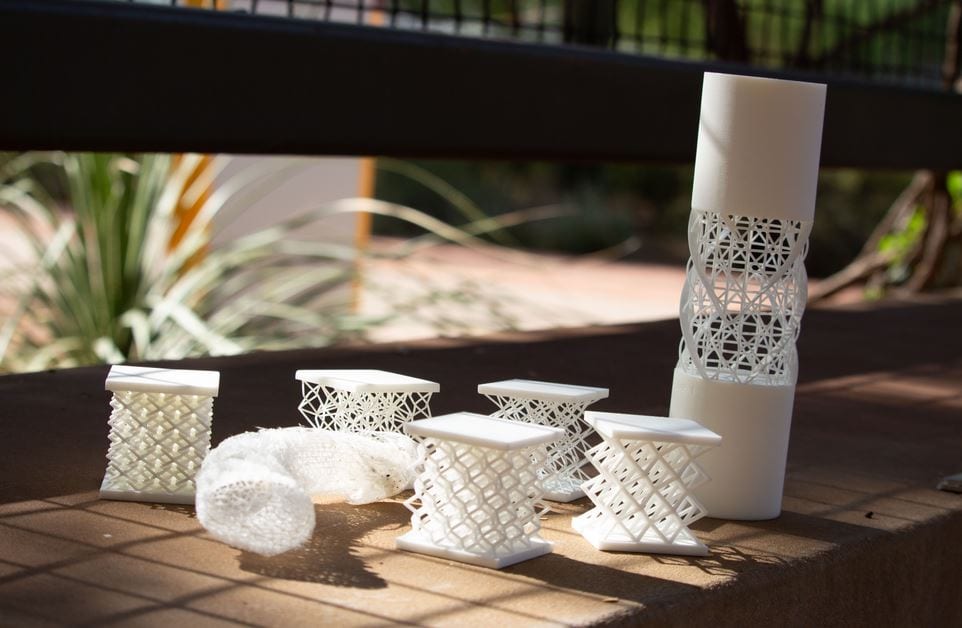Nature is the ultimate testing ground and source of inspiration for many engineering principles.
Through the trial and error of natural selection, organisms develop innovative methods to withstand and even thrive in adverse conditions. By applying natural features to human-made designs, a practice known as biomimicry, engineers can develop creative and sustainable ways to tackle technological challenges.
One feature found abundantly in nature is the lattice, which connects components of a structure in a strategic pattern to form a durable design. A lattice that can maintain its shape during the application of external force is known as a compliant mechanism. From a finger trap to the support beams of a house or the hexagonal structure in honeycombs, lattices are everywhere.
Dhruv Bhate is an associate professor of engineering who teaches additive manufacturing, biomimicry and design in the School of Manufacturing Systems and Networks, part of the Ira A. Fulton Schools of Engineering at Arizona State University. He and a team of researchers are using design principles exhibited by the exoskeleton of the Venus’ flower basket sea sponge to develop a lattice configuration with novel weaving patterns to achieve structural compliance.
Because of its exceptional design and durability, members of Bhate’s lab, 3DX Research, began studying the sea sponge in collaboration with Clint Penick, an assistant professor of biology at Kennesaw State University, and Nikhilesh Chawla, Ransburg Professor of material science and engineering and acting head of Purdue University’s School of Materials Engineering.
“I think we all went into this project thinking, ‘We’re going to figure out how to build stiff materials,’ but it was actually the opposite,” Penick said. “When we started breaking apart the sponge and assessing how it came together, what we found led to one of the most compliant lattices ever created.”
As they deconstructed the exoskeleton, they noticed that its sturdy woven structure was more fragile and less connected than they had anticipated. The individual beams were brittle, and several junctions consisted of nodes that didn’t connect but instead rubbed against each other.
Yash Mistry, a mechanical engineering doctoral student in Bhate’s lab, examined the impact of the decoupled nodes.
“There are a lot of ways we can control the stiffness and components in a structure,” Mistry said. “I wanted to explore how we can arrange the decoupling of nodes across it to achieve compliance.”
Sea sponge exoskeleton examination
In his most recent publication in the scientific journal Nature Communications Materials, Bhate explained how the team discovered that the sea sponge’s exoskeleton selectively weaves certain junctions to allow for compression and provide an even distribution of force, ultimately achieving compliance by being squishy.
The team at Purdue University performed X-ray tomography scans on the Venus’ flower basket to analyze its structure. From these scans, they determined three distinct patterns of selective decoupling.
Bhate’s team replicated the structures in 3D-printed models. They collaborated with Oliver Weeger, an assistant professor of cyber-physical simulation at the Technical University of Darmstadt in Germany, who performed a series of simulations on the models to determine compliance.
The results suggested that decoupling leads to significant increases in compliance under compression.
“Most lattices are designed to be lightweight and stiff,” Bhate said. “What we’ve done is inverted that and found a lattice that can squish. We’re exploring the idea of a woven anti-lattice while using lattice-based design ideas.”
The design has potential applications in sensory detection as well as absorbing and harvesting energy because of its sensitivity to the detection and distribution of applied force. The team is working with Xiangfan Chen, an assistant professor of mechanical engineering and materials science and engineering in the School of Manufacturing Systems and Networks, to examine how these woven lattices may be fabricated at very small scales.
“We wanted to expand our library of design capabilities and provide a tool to promote a new way of thinking about design, knowing that we would find meaningful applications for things we haven’t thought of yet,” Bhate said.
Lattice design collaboration
Bhate credits the project’s success to Mistry’s creativity, organization and communication skills. Mistry’s take on the project has propelled the project to new heights, Bhate said, noting that his designs motivated the project’s researchers to go the extra mile.
“We set out to find new lattice designs in nature that would behave unexpectedly, with confidence that if it evolved organically, it must be good for something,” Bhate said. “A scientific experiment often begins with an interesting question that is pursued for its own sake, and engineering tends to solve problems. Collaborations like this allow us to do both, and that is its own special kind of joy.”
As a biologist, Penick said he enjoys collaborating with engineers and understanding their different perspectives.
“It’s great to pull ideas from engineering and have engineers pull from biology to see where we’ll find these surprises,” Penick said. “Especially when I get to work with great engineers who are curious and easy to talk to.”
Subscribe to AM Chronicle Newsletter to stay connected: https://bit.ly/3fBZ1mP
Follow us on LinkedIn: https://bit.ly/3IjhrFq
Visit for more interesting content on additive manufacturing: https://amchronicle.com


